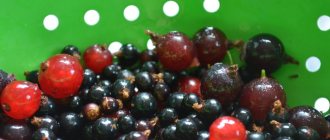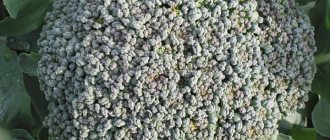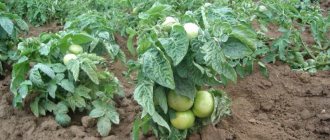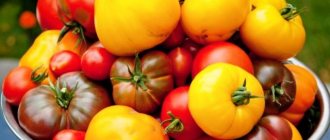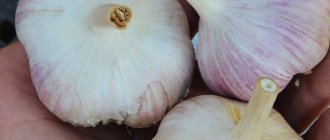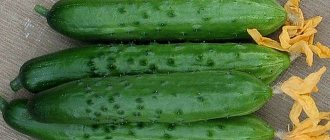If you love broccoli and want to grow this wonderful vegetable yourself in the climate of the Moscow region, this article is for you. Because today I will tell you about the best varieties of broccoli that will develop well in such conditions. For convenience, I will divide them into groups, separately highlight those that are suitable for open ground, which are easier to grow in greenhouses, and also rank the varieties by ripening time.
About cabbage
Broccoli in appearance resembles cauliflower, of which it is a “relative”. Main differences:
- The color of the heads ranges from deep green to purple.
- They are less dense and more friable.
- Arranged on fleshy stems up to 15-20 cm long.
The appearance of the main types of cabbage is slightly different:
- Calabrian, more familiar to our eyes, is a head of dense inflorescences on a fairly thick stem.
- The head of stem (Italian) broccoli is made up of many stems (more delicate in taste) with small inflorescences.
In Russia, varieties of green “variations” of flowers that bear fruit in the fall are more common. In Western Europe, varieties of purple and white broccoli are often sown before winter and harvested in early spring.
Not only healthy, but also a decorative vegetable
It is customary for us to plant broccoli with green inflorescences. In Europe, purple and white varieties are very common. They are also useful, and also very decorative. The online store Russian Ogorod-NK, LLC SPK APD sells broccoli seeds of the Purple Queen variety with purple heads. The variety is very beautiful during the flowering period. The Purple Queen produces its main harvest in the second half of summer, continuing to bear fruit until mid-autumn.
Broccoli variety Purple Queen with purple inflorescences
Variety selection criteria
Like most crops, broccoli seeds are divided into varietal and hybrid.
- The varieties are suitable for removing seeds. Especially tasty. They ripen longer.
- Hybrids are not suitable for saving seeds for a new harvest. In the first generation they retain the necessary qualities well and are designated with the sign “F1”. Practically not damaged by pests. They can be very fertile. They ripen earlier and are stored longer. They are somewhat inferior in taste.
Broccoli has different varieties and hybrids, but you can choose them according to two main criteria:
- Ripening time of varieties. Thus, the first hybrids reach the “ready stage” by day 50, and late varieties mature up to 140 days or more. Therefore, it is extremely important to choose early ripening varieties for short summer conditions.
- Productivity . It can vary from 1 to 4 and even 7 kg per meter of planting area, depending on the quality of the seeds and other characteristics.
Also, different types of broccoli differ in harvest season, growing technology, resistance to stressful weather situations, fruit weight, preferred method of consumption and some other characteristics.
Popular varieties
It is impossible to single out the best “representatives” of broccoli due to the fact that each gardener chooses them according to his own rules. But there are still varieties that are rated positively by the majority of lovers of this vegetable.
Early ripening
Terms of technical maturity from 60 to 100 days.
"Batavia F1". In most areas it is assessed as an early-ripening broccoli hybrid, although according to the State Register for personal subsidiary plots it is included as a mid-season. Green leaf with a gray tint, wavy along the edge, bubbly. The head is round in shape, with small tubercles, dense. The secondary heads are easy to separate. The weight of the central head is from 0.7 to 1.5 kg, the side ones - 200 grams or more. The readiness period for the first cabbage inflorescences is 2 or a little more than a month after planting 30-day-old seedlings. The best time for planting is from March 15, for a month. It is possible to plant seeds after April 20. The harvest is collected on average 2.6 kg per unit area. Tolerates heat well. On the side shoots, "Batavia" bears fruit until frost. Doesn't last long. Best eaten fresh, although suitable for processing and freezing.
"Linda" is a cabbage variety made from first generation hybrid seeds. Depending on the area, the ripening time of the main fruit is 85-105 days, weight 300-400 g, color rich green, elliptical shape. It grows up to 7 lateral inflorescences, weighing up to 50-70 g. The height of the broccoli bush is average. Seedlings are sown at the age of 35-45 days, from mid-March at intervals of 10 days until the end of April. Consumption fresh and canned. A complex of vitamins and amino acids, a lot of iodine. They remove 3-4 kg per unit of growing area.
"Lord F1". Very tasty, high yielding. Planting broccoli cabbage seeds for seedlings from March 15 for a month, put on the ground after April 20. You can use seeds. The sheet is slightly corrugated. The stem is powerful. The maximum weight of the central head is 1.5 kg, round-flat in shape, dark green in color, fine-grained, the inflorescences are of excellent quality and are easy to separate. Technical maturity of the Lord variety is 60-64 days. Side fruits up to 200 g, formed before frost. "Lord" is not susceptible to downy mildew. Successful to grow outdoors. Maximum fees per square meter 4 kg. Improves the functioning of the heart and blood vessels.
"Monaco F1". The period of technical maturity is 70-75 days. The stem grows up to 80 cm. The age of seedlings for open soil is 45-55 days. The central head is round-flat, dome-shaped, weighing 1.5-2 kg, dark green. There are no secondary inflorescences. The yield of "Monaco" is 4.2 kg per square meter. Can be obtained twice per season by sowing seeds in “waves”. High consumer qualities. There is no bitterness. Does not crack during transportation. Resistance to bacteriosis. Juicy taste fresh, freezes well.
"Tone". The variety has been known for a long time. Ripening time is 70-90 days. A large head of cabbage up to 200 g of medium density can quickly fade into color. A slightly brownish tint is possible. Side shoots weighing up to 50-70 g grow together. In March, the seeds are sown “for seedlings”, outdoors under temporary shelter in early May. First training camps from mid-June. With proper care, you can cut it until October. If left in the beds even lying down, the variety can give a “gift” in the form of frozen, but absolutely full-fledged heads even in November and early December. Delicate delicious taste. Rich composition of vitamins and mineral salts. The variety is good for use in any form. Harvesting from each unit of area is 1.6-2 kg.
How to plant broccoli seeds in open ground. Planting broccoli seedlings. Landing dates
Let's take a closer look at how to harvest this wonderful vegetable. Since the climate of temperate latitudes prevails in most regions of Russia, the most optimal, and for many regions the only, way to plant broccoli is to plant it in open ground from seedlings.
As I already said, seedlings are planted approximately 40-50 days before the expected date of planting on the site. I will tell you below how to grow seedlings from seeds.
Select cabbage seeds:
Pay attention to the ripening period. I'll show you what seeds I use on my site: Tone:
Tone:
An early ripening variety of domestic selection. Early ripening, ripening in 60-90 days from germination.
Characteristics of the plant. The rosette is semi-horizontal, with a diameter of 19…23 centimeters. The heads are dark green, but in cold and hot weather the color can acquire a brownish-brown tint, dense, weighing 160...200 grams. Productivity up to 2 kilograms, at the first harvest up to 1 kilogram per square meter. 5...8 days after harvesting the mature heads, the heads of the second and subsequent orders grow. The taste is good. Recommended for canning.
Sowing dates. Sowing seedlings in mid-April. Picking in the cotyledon phase. Planting in the ground in mid-May.
Sowing geometry: distance between rows 60cm, between plants 20-30cm.
Vitamin:
An early ripening variety of broccoli cabbage of domestic selection.
Beginning of ripening: when sowing seeds in February, it produces a harvest from early June to September.
Characteristics of the plant. The rosette is semi-horizontal with a diameter of 40...58 centimeters. The heads are dark green, dense, weighing 133...354 grams. Productivity up to 2.4 kilograms per square meter. 7...10 days after harvesting the mature heads, the heads of the second and subsequent orders grow.
Care. The variety requires timely harvesting, as the heads quickly loosen.
Fiesta F1:
Mid-early highly productive hybrid of broccoli cabbage.
Beginning of ripening: 80 days from germination to technical ripeness.
Characteristics of the plant. The leaf is long, blue-green, heavily dissected, with a faint waxy coating. The head is medium sized, rounded flat to rounded, partially covered, dark green, very dense, medium lumpy. The taste is excellent. The hybrid is characterized by uniform ripening of the crop. Recommended for home cooking and canning. Productivity is 2.5...3.5 kilograms per square meter.
Sowing dates. Sowing seedlings in mid-April. Picking in the cotyledon phase. Planting in the ground in mid-May.
Sowing geometry: distance between rows 50cm, between plants 30cm.
Disease resistance. Resistant to Fusarium wilt.
Linda:
Broccoli variety of Czech selection Moravoseed.
Mid-season, the period from full germination to technical ripeness is 85 days.
Characteristics of the plant. The plant is medium-sized, the leaves are raised. The head is elliptical, medium size, dark green, without anthocyanin, medium lumpy, medium dense, no covering leaves. The head is dark green, weighing 300...400 grams. After cutting, up to 7 heads of offspring grow. Productivity is 3...4 kilograms per square meter.
Sowing geometry: distance between rows 50cm, between plants 50cm.
We've decided on the seeds.
I would like to note that cabbage seeds are already prepared for sowing, they are treated with a growth regulator, fungicide and coated with a dye.
How to choose a variety
Asparagus cabbage, or broccoli, as it is commonly called, is an annual plant with a height of 70 to 100 cm. Broccoli cabbage is somewhat reminiscent of cauliflower in appearance. Although it is almost twice as good in taste. It contains much more protein and mineral salts, as well as vitamin C. For this, adherents of a healthy diet especially love it. Like all crops, this vegetable is divided into hybrids and varietals. But what should you be guided by when choosing a variety of this cabbage?
There are two main criteria by which you need to choose a broccoli variety:
- Vegetable ripening time. Some species ripen as early as 45-50 days, while others ripen for more than four months.
- Productivity. It can reach up to 8 kg per 1 m2 of area. In addition, the seasonality of harvesting, resistance to frost and drought, insect pests, the weight of the fruits themselves, how large or not they will depend on the variety.
That is why gardeners approach the choice of broccoli varieties with special care. Otherwise, the wrong choice of broccoli, for example due to bad weather conditions, can lead to its flowering, which significantly reduces the quality of the crop. To prevent this, professionals recommend paying attention to zoned varieties.
Features of the plant
All varieties of broccoli grow in open ground. Seeds germinate in different regions of the country with any climatic conditions. Cold-resistant crops grow in Siberia. Some seeds are suitable for the middle zone. The main advantage of the crop seeds is that they are suitable for growing in Siberia.
Species differences between varieties are in predispositions, endurance and appearance. The Calabrese variety looks more like dense inflorescences and has a bright green color, but Italian broccoli takes on the appearance of asparagus. This species is eaten whole along with the stems.
The beneficial qualities of the plant surpass all known vegetables. This plant is an indispensable part of the diet for vegetarians. The protein contained in broccoli can replace chicken and beef proteins. In addition, the culture contains a large amount of vitamins, minerals and amino acids necessary for the healthy development of the body, and does not contain fat.
Broccoli is the healthiest vegetable in the world
Growing seeds is beneficial because the crop is unpretentious, grows in open ground and does not require special care. Cabbage is in demand as a food product, as it is irreplaceable due to its qualities. The plant contains more vitamin C than common citrus fruits. The seeds of the crop are not difficult to acquire. The seeds of the plant are planted in open ground and within three to four months the crop produces a harvest, depending on which seeds are selected.
Cabbage is ideal for those who are on a diet. Since vitamins and minerals make it possible to compensate for restrictions in the prescribed human diet.
Subscribe Stay up to date with new products on our site
An increasing number of gardeners are becoming interested in growing tasty and healthy vegetables on their plots. Among them, different varieties of broccoli are gaining popularity - an unpretentious plant that has a whole “bouquet” of vitamin and mineral “benefits”.
Early ripening species
Let's look at those broccoli varieties that have received the maximum number of positive reviews from gardeners. The period of full ripeness of early ripening species can range from 60 to 100 days.
Batavia
The weight of Batavia hybrid heads of cabbage can reach up to 2 kg. The first inflorescences will be ready within 30-40 days after planting the seeds in open ground. The best time to plant this hybrid is mid-March to mid-April. This species tolerates hot weather well. Batavia can be consumed fresh or frozen.
Agrotechnical recommendations
There are two ways to cultivate broccoli: seedlings or direct sowing in the soil. In the middle zone and areas of “risky farming”, it is usually grown through seedlings.
To prepare seedlings, seeds are sown in late March or early April. Seedlings aged 35-45 days are planted in beds. Broccoli grows best in well-moistened, fertile soil. To protect plants from clubroot, it is recommended to add a little lime to the holes.
With the seedless method, seeds are sown in beds at the end of April or a little later, depending on weather conditions.
The timing of sowing and planting seedlings in open ground is planned taking into account the climatic characteristics of a particular area and the weather forecast
Care includes the following activities: watering, fertilizing with organic or mineral fertilizers, loosening the soil, weeding, protection from pests.
The heads are cut off while they are still quite dense and the buds have not opened. Specimens with blooming yellow flowers are not eaten. It is recommended to use broccoli for cooking within 1-2 days after harvesting; it can be kept in the refrigerator for up to 1 week, first wrapped in plastic wrap.
For the winter, it is best to freeze cabbage inflorescences - this way they are stored for a long time and almost do not lose their beneficial properties.
Mid-season varieties and hybrids
In four months you will receive your first harvest
Medium ripe cabbage varieties ripen in approximately 100 to 130 days from the moment the seeds germinate.
Ironman
Anyone who has already grown broccoli with seeds notes the high yield of this variety. This is a dome-shaped hybrid whose leaves can be either green or blue. The weight of the fetus reaches 0.5 kg. This variety grows well in open soil and tolerates field conditions well. This crop tends to withstand frost and drought. In addition, the Ironman variety vegetable has good taste. Ideal for growing in central Russia and the Urals.
Fortune
Broccoli seeds of this type have a high yield, which is proven by many years of positive experience of farmers and gardeners. The entire vegetable ripening cycle takes place from 80 to 90 days. Weight – up to 200 g. The seedlings are brought to open ground approximately 30-40 days after planting. Fortuna can withstand frost, and it stores well. It is loved for its light dietary taste, which is especially revealed when eaten fresh.
Atlantic
The growing season is about 130-135 days after the seeds have been sown in seedling boxes. The maximum weight of the head is approximately 400 g. Atlantic is a great option for those who prefer to eat broccoli fresh.
Pests and diseases of broccoli
During the growing season, broccoli plantings may be attacked by pests. The most dangerous of them are:
- Small insects, aphids, that parasitize the lower part of plant leaves. They suck the juices from the crop, which leads to curling of the leaves. Aphids multiply quickly, colonizing more and more new areas.
- The second pest, the cabbage fly, lays its eggs at the bottom of the broccoli. Soon larvae emerge from them and begin to chew the plant pulp near the root system, which will lead to the death of the cabbage.
- The cruciferous flea beetle eats away areas on the leaves and stems of the crop, which leads to rapid drying out of the bushes.
- The cabbage butterfly circles over the plantings to lay eggs. In the future, caterpillars will appear from them, which will chew the shoots and leaves of broccoli.
- Snails and slugs pose a particular danger to young plants; they destroy seedlings completely.
Chemicals, pesticides and folk remedies will help destroy all of the listed pests:
- Aphids can be expelled from the area after spraying the plants with an infusion of potato tops or a soap-ash solution.
- Anometrine or corsair will help defeat the cabbage fly.
- To destroy the cruciferous flea beetle, the drug Foxima is suitable.
- You can defeat cabbageweed with the help of Rovikurt.
Diseases:
- Blackleg is considered one of the most dangerous diseases of broccoli. This disease mainly affects seedlings, causing thinning of the lower part of the stem and further death of the crop. Proper watering of young plants and treating them with Planriz or Fitosporin will help prevent the appearance of blackleg.
- Clubroot appears on broccoli in the form of oval or spherical growths, which over time turn brown and become covered with putrefactive spots. Cabbage affected by the disease is stunted in growth and begins to wilt. It is impossible to cure this disease; correct crop rotation on the site is considered to prevent its occurrence.
- With tracheomycosis, broccoli leaves become yellow-green, soon become deformed and wither, and then completely fall off. The fungicide Benzimidazole, as well as timely removal of diseased plants, will help defeat this disease. Affected crops are removed from the site and burned.
Follow the tips described in the article. Proper care of broccoli will help you get a rich harvest of healthy vegetables. And even a novice gardener can cope with growing this crop.
The best varieties of late-ripening broccoli
The full ripening cycle for these cabbage varieties reaches 150 days. You can grow it faster - in about 135 days. Everything depends on weather conditions. Let's look at the best varieties of broccoli with late ripening heads.
Agassi
This variety of cabbage loves heat very much. It is under such conditions that broccoli seeds germinate well. It has medium tubercles and a regular round shape. Weight can reach up to 1 kg, most often about 800 grams. This cabbage grows well both outdoors and in a greenhouse. In addition, Agassi can be stored for up to 5 months, which undoubtedly can be considered an advantage of the variety.
Marathon
This variety of broccoli does not like heat and tolerates cold well. The variety is valued in the Urals, in central Russia. It must be planted in early spring; the first harvests can be obtained within 85 days after the broccoli seeds are planted. Among those who love and appreciate broccoli, the Marathon variety is especially popular.
In addition to the late-ripening varieties of cabbage listed above, we also recommend paying attention to varieties such as Laki and Continental. However, when choosing late-ripening hybrids, remember that they are not particularly popular, because such varieties of cabbage do not have high taste. But late-ripening varieties ripen by the beginning of autumn, which means that this type of broccoli can be perfect for preparing winter preparations.
Features of the climate in the region
To successfully grow broccoli in a garden in the Moscow region and other areas of the middle zone, you should clearly understand the conditions for cultivating such cabbage.
The climate features in the region are as follows:
- temperate continental type;
- warm summer – average temperature 17-22 °C;
- sufficient humidity;
- in summer, partly cloudy weather prevails;
- the driest season is spring;
- snow melts in March;
- in the first half of autumn it is usually warm and dry;
- the beginning of frosts in November.
The most useful varieties
Choose the variety that suits you
Let's look at the healthiest varieties and hybrids of broccoli.
Calabrese
This is not cauliflower, as many people think. A subspecies of broccoli, which is especially popular in Finland. It has a round and dense head, which can be of different colors: green, yellow and even purple. The average weight reaches approximately 400 grams. It is perfect for both freezing and pickling. It is also useful to eat it raw, since the calabrese cabbage variety contains many vitamins and substances beneficial to the body. Broccoli seeds of this variety have good survival rate and germinate well.
Blue spindle
An early-ripening hybrid that gardeners love for its incredibly high yield. The weight of such cabbage reaches up to 0.5 kg. In terms of its nutritional value, usefulness, and vitamin content, Blue Spindle is superior even to cauliflower.
Jorman
The full ripening cycle is achieved approximately 70-80 days after planting the seeds. This Yorman cabbage can be consumed both fresh and after processing. But it is worth considering that for processing it is best to use fruits from sowing done at the end of May.
Beaumont
The best varieties of broccoli include the Beaumont variety. It was obtained as a result of Dutch selection. The harvest can be obtained 3 months after the broccoli seeds were sown. The average weight of cabbage reaches 800-900 grams, although sometimes the weight increases to 2 kg. This variety is prone to rapid wilting, so it is best to freeze or process cabbage.
Growing broccoli in the Moscow region: choosing the best variety, tips for planting and care
Whatever they say, the climate of the middle zone and the Moscow region is best suited for growing exotic cabbage. To obtain a summer harvest, an open bed is sufficient, but for early and late production, you can use a greenhouse or film cover.
Broccoli is a fairly early ripening crop, so it can be grown without seedlings. Seeds are sown in open ground from mid to late April. Cabbage grows and develops well in moist and nutritious soils and easily tolerates frosts down to -7 °C. After the emergence of shoots and several true leaves, the seedlings are planted on a ridge at a distance of up to 50 cm from each other. About 30 cm is maintained between the rows. In the conditions of the Moscow region, almost any variety of this crop can be grown.
The following have gained popularity among gardeners:
These are varieties of different ripening periods, but harvesting cannot be delayed. If you do not remove the head in time, the side branches will produce unsaleable small heads of cabbage. By observing the deadlines, you can get a second harvest of marketable heads.
The “Vitaminnaya” variety belongs to the early-ripening varieties, the ripening period of which does not exceed 80-100 days. The head is not stored fresh for long; it is consumed first or processed. Cabbage is dark green in color, the marketable weight of the heads is up to 250 g. The second wave of the harvest produces smaller heads of cabbage. The yield of the variety is high, more than 2.5 kg per meter of bed.
Broccoli "Fiesta" is considered a mid-season variety, the advantage of which is the density of the heads and the absence of side branches. The pulp is juicy and tasty. The variety is highly resistant to wilting and other characteristic diseases. Productivity up to 3.5 kg per meter of planting. Cabbage is universal in use. It can be frozen for winter consumption, eaten immediately, or stored fresh for about two weeks.
The late-ripening variety “Laki” has a less delicate taste, but is stored longer than others. Cabbage is mainly used for canning and freezing. The ripeness of the heads occurs on the 130-145th day of cultivation. The heads of cabbage are dense, well covered with leaves, weighing up to 1 kg. The variety is resistant to powdery mildew, cold snaps and does not require fertilizing.
High-yielding varieties of broccoli that are best grown in Siberia with characteristics and photos
In Siberian conditions, predominantly early-ripening varieties of broccoli are grown, because the short summer does not allow for a good harvest from late varieties. It is worth taking a closer look at the hybrids of this crop, which are distinguished by their productivity, endurance and unpretentiousness. Gardeners have identified several varieties for themselves:
These varieties and hybrids are grown through seedlings, which are transferred to a permanent place at the end of May. But even here you need to be careful. If the weather suddenly worsens, you should build a greenhouse or cover the plantings with non-woven material.
The varieties “Venus” and “Vyarus” belong to the early varieties of broccoli. The hybrid "Venus" does not form side shoots and heads, unlike "Vyarus". The head of cabbage is dark green in color, very dense, with good taste. The ripening of the fruits occurs simultaneously, on the 80-100th day of cultivation, the heads by this moment reach a weight of 600 grams. The average yield of the “Venus” variety is up to 3.5-4 kg per meter of area. The hybrid is resistant to major diseases and fusarium.
The variety "Vyarus" bears fruit in two waves. The first harvest is formed on the main stem; the heads of cabbage are small, weighing only 150-200 grams. The second time the lateral branches bear fruit. The heads are dense, bluish in color, and tasty. The culture is resistant to low temperatures and easily tolerates heat. Productivity is within normal limits; up to 3 kg of cabbage is harvested per meter of plantings.
The Calabrese variety is considered medium in terms of ripening. It takes more than 100 days to form a commercial head. The plant is quite cold-resistant, bluish-green in color, with a dense head. The main crop is formed on the central shoot; the head reaches a mass of no more than 500 grams. After cutting, many lateral branches are formed, which produce small heads of cabbage. The yield of the variety is good.
The Arcadia variety is suitable for growing in greenhouses and film greenhouses. The head consists of many small dark green inflorescences. It takes 110-115 days for the harvest to ripen. The average weight of heads of cabbage is 450-500 g, the side heads do not grow more than 100 g.
Subspecies of broccoli
Broccoli varieties are varied, but similar in their characteristics. The main benefit of growing this crop is that there are numerous varieties of broccoli that can grow in different regions of the country. They survive and grow profusely in all climates. Each variety has its own characteristics and acceptable growing conditions.
You will rarely find broccoli varieties in households, since few farmers want to deal with it. With all its diversity, the best varieties of broccoli are grown mainly on an industrial scale.
The difficulty of growing a crop lies only in choosing the right variety that will take root in your climatic conditions; the rest will not require much effort from you.
Broccoli Lazar F1 ripens in just 60 days after planting
Varieties of broccoli:
- Tone. The species is characterized by taste qualities superior to others. The ripening period is early, taking seventy days from the formation of the first shoots. The entire fit fits at once, evenly. Weight and height are two hundred grams and eight centimeters. The bunch is large and green. At the site of the cut, shoots grow, gaining a weight of fifty grams. The harvest will be about seven kilograms per square meter.
- Broccoli F1. A popular type of culture. The suitable temperature is twenty degrees, they ripen in an average period, that is, neither early nor late. The bunch is large, green in color. It can be stored for a long time and is intended for fresh consumption, suitable for heat treatment.
- Lazar F1. From the moment of planting, the crop germinates two months later. This is the fastest ripening type of broccoli. External characteristics and parameters are no different from previous types.
- Linda. Ripens after three to four months. The weight of the beam can reach four hundred grams.
- Vitamin A. It bears fruit three months after planting. The size is small, weight about three hundred grams. The color of the plant is dark green.
- Arcadia. The germination period is average, weight is four hundred grams, color is green, the structure of the head is hilly.
- Vitamin. The harvest is ready before it reaches three months. Refers to a species with early ripeness. The weight of the bundle is about three hundred grams, but does not reach this limit. This species requires attention; it loses its quality if the harvest is not harvested on time.
- Dwarf. The grey-green color of the head reaches a weight of three hundred grams. The second harvest from the moment the first harvest produces heads of two hundred grams. Suitable for growing in the northern regions of the country. As well as varieties of Calabrese, laser, varnish, Monterey.
- Continental. This species has a leading position in taste, the weight of the bunch reaches five hundred grams, and it ripens late.
- Monterey. Tolerant to species diseases and pests. It ripens early, a bunch can weigh up to a kilogram, but there are no repeated shoots.
Broccoli is a type of cauliflower. This plant is unpretentious, but depends on climatic conditions. In appearance it is similar to ordinary cabbage, but is inferior in size. The seeds of many plants are suitable for growing in Siberia, the Urals, and the Moscow region. The culture is suitable for growing in open ground.
Broccoli Monterey - an early and disease-resistant variety
